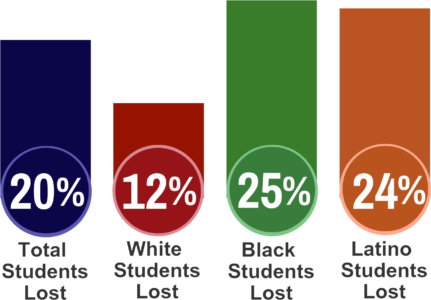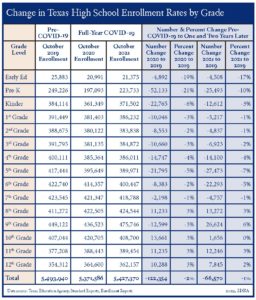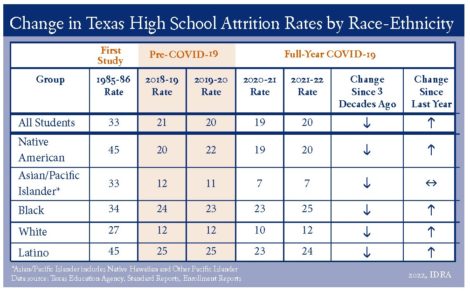By Charles A. Cavazos.• IDRA Newsletter • October 2022 • 
IDRA’s latest annual attrition study found that 20% of the freshman class of 2018-19 in Texas public schools left school prior to graduating in 2021-22. This is an increase over last year’s 19% finding. Texas has not experienced an increase since 2015-16.
Double-digit disparities among racial and ethnic student groups remain. This year’s study is the 37th in a series of annual reports on trends in dropout and attrition rates in Texas public schools.
IDRA conducted the first-ever comprehensive study of school dropouts in Texas for the 1985-86 school year. Since statewide data on school dropouts did not exist then, IDRA developed an attrition methodology that has since become a standard method used by education researchers.
IDRA continues to conduct attrition analyses each year to assess Texas schools’ abilities to hold on to their students until they graduate. Attrition rates are an indicator of a school’s holding power, or ability to keep students enrolled in school and learning until they graduate. In simplest terms, attrition is defined as the decrease in size or number. Therefore, an attrition rate is the percent change in grade level enrollment between a base year and an end year.
Since the shift to remote learning during the pandemic, schools continue to struggle to reconnect with hundreds of thousands of students. An IDRA study found that the problem is bigger than any single school strategy. IDRA’s report, Plugged in, Tuned Out – A First Examination of Student Engagement Patterns in Texas Public Schools During COVID-19, found that, in many parts of Texas, student disengagement during the pandemic was a direct result of limited broadband access (Quintanilla-Muñoz, 2021). Schools lost touch with Black students and Latino students at over twice the rate of white students.
The 2021-22 statewide attrition rate of 20% is 13 percentage points lower than the initial rate of 33% found in IDRA’s landmark 1985-86 study and 1 percentage point higher than last year. The overall high school attrition rate in Texas has ranged from 19% to 25% over the past nine years.
Across racial and ethnic groups, attrition rates are lower than they were almost four decades ago when IDRA conducted the first attrition study. In this year’s study, the attrition rate of each racial-ethnic group increased by 1 or 2 percentage points, except for Asian American students, whose rates remain unchanged. Key findings of the latest study follow.
Texas public schools fail to graduate one out of every five students.
Nearly 89,000 students from the 2018-19 freshman class were lost from public high school enrollment in 2021-22.
For the class of 2022, Latino students and Black students were two times more likely to leave school without graduating than white students.
In four decades, the overall attrition rate declined from 33% in 1985-86 to 20% in 2021-22, which is a 39% improvement.
The attrition rate gap between white students and Latino students decreased by 33% from 18 percentage points in 1985-86 to 12 percentage points in 2021-22.
The attrition rate gap between white students and Black students increased by 86% from 7 percentage points in 1985-86 to 13 percentage points in 2021-22.
IDRA conducts a forecast analysis of the expected year that the attrition rate will equal zero. Last year’s analysis predicted that, barring significant improvements in policy and practice, Texas will continue to have attrition rates ranging from 19% to 25% and will not reach an attrition rate of zero until the year 2038-39.
School closures and disruptions caused by the COVID-19 pandemic may have serious implications for student learning, student engagement and school dropout rates. The Office for Civil Rights observed a negative impact by the pandemic on academic growth and d eepened disparities in access and opportunity for students of color in public schools (2021).
eepened disparities in access and opportunity for students of color in public schools (2021).
Pottiger studied comprehensive graduation rates and, since 2007, there was a rapid, steady increase in graduation rates across the country until 2019 – from around 73% to 86%, driven by Black and Latino students and students in families with low incomes. Black student graduation increased around 2% from 2019-20 but dropped in 2020-21 by 2.5%. The sharp fall in graduation rates only a year later speaks to schools being unable to fully support Black students (2022).
Similarly, preliminary data from 25 states that covered around 57% of the student population showed that graduation rates for Latino students declined slightly in 2020-21 (Unidos US, 2022).
Some education experts believe that remote learning during COVID-19 placed students at higher risk of dropping out of school. Factors include the loss of connection with peers and school support, reduction in educational services and extracurricular activities, and loss of other activities and events that help to engage students (De La Rosa, 2020).
IDRA developed a resource, Ready-Renew-Reconnect! Proven Strategies for Re-engaging Students Who Need You the Most, that outlines key factors that keep students coming back and how schools can help them feel a sense of success day after day (Bojorquez, 2021). It shows strategies that have been proven successful, such as in the IDRA Valued Youth Partnership program. IDRA’s attrition full study for 2021-22 will be published soon.
Resources
Bojorquez, H. (2021). Ready-Renew-Reconnect! Proven Strategies for Re-engaging Students Who Need You the Most. IDRA.
De La Rosa, S. (September 21, 2020). Ed experts fear rise in dropouts as remote learning continues. Education Dive.
OCR. (June 2021). Education in a Pandemic: The Disparate Impacts of COVID-19 on America’s Students. U.S. Department of Education, Office for Civil Rights.
Pottiger, M. (May 18, 2022). What’s Going on With Black High School Graduation Rates? Word in Black.
Quintanilla-Muñoz, C. (2021). Plugged in, Tuned Out – A First Examination of Student Engagement Patterns in Texas Public Schools During COVID-19. IDRA.
Unidos US. (July 2022). Latino Student Success: Advancing U.S. Educational Progress for All.
Charles A. Cavazos is an IDRA education associate and data analyst. Comments and questions may be directed to him via email at charles.cavazos@idra.org.
[©2022, IDRA. This article originally appeared in the October 2022 issue of the IDRA Newsletter by the Intercultural Development Research Association. Permission to reproduce this article is granted provided the article is reprinted in its entirety and proper credit is given to IDRA and the author.]


